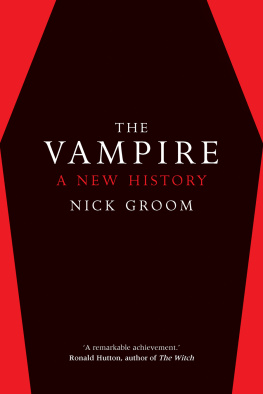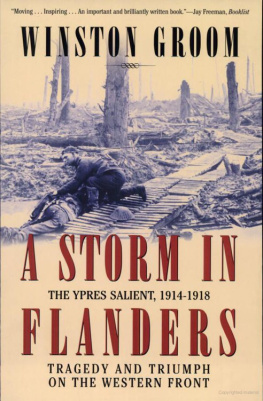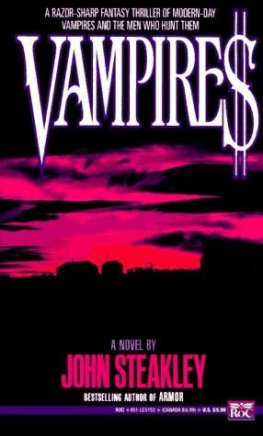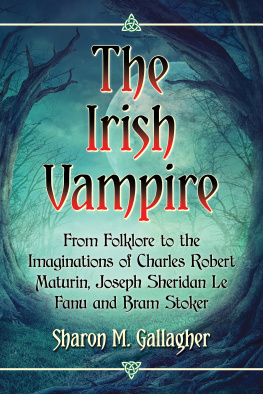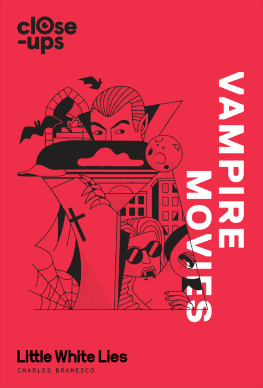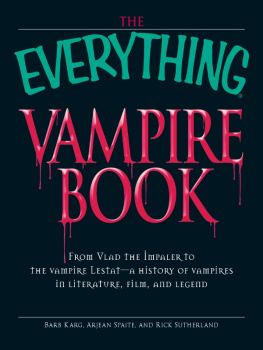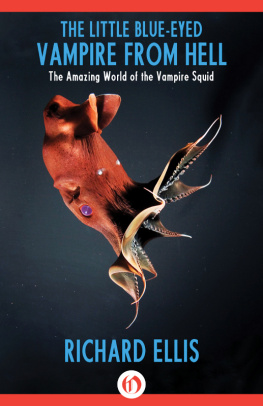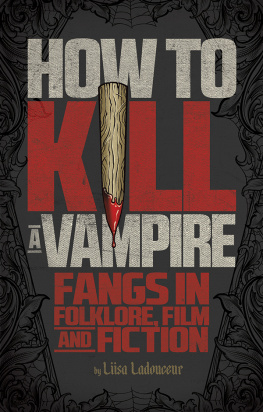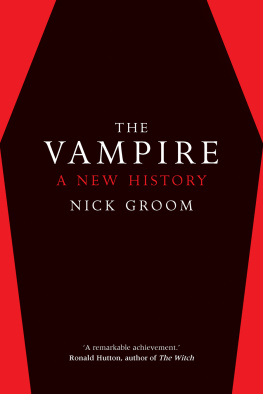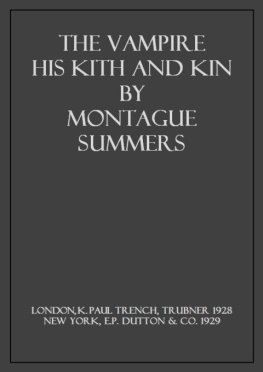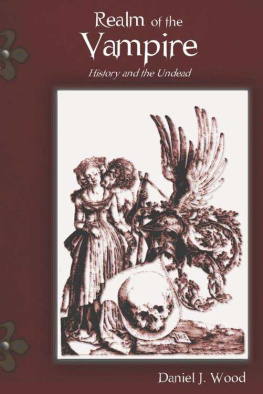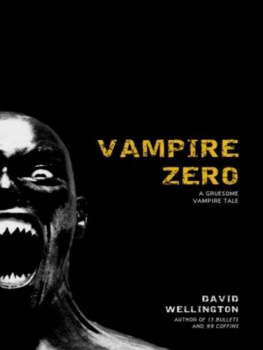THE VAMPIRE

Extract from The Waste Land taken from The Poems of T.S. Eliot, Volume 1 (Faber & Faber Ltd, 2015). Copyright Set Copyrights Limited, 2015.
Copyright 2018 Nick Groom
All rights reserved. This book may not be reproduced in whole or in part, in any form (beyond that copying permitted by Sections 107 and 108 of the U.S. Copyright Law and except by reviewers for the public press) without written permission from the publishers.
For information about this and other Yale University Press publications, please contact:
U.S. Office:
Europe Office:
Set in Adobe Garamond Pro by IDSUK (DataConnection) Ltd
Printed in Great Britain by Gomer Press Ltd, Llandysul, Ceredigion, Wales
Library of Congress Control Number: 2018951682
ISBN 978-0-300-23223-3
A catalogue record for this book is available from the British Library.
10 9 8 7 6 5 4 3 2 1
For my parents
For her house inclineth unto death, and her paths unto the dead.
None that go unto her return again, neither take they hold of the paths of life.
Proverbs 12:1819 (1611)
Mortui non mordent.
Proverbial: dead men do not bite;
attrib. by Desiderius Erasmus to Theodotus of Chios (first century BC )
We could hardly expect anyone, even did we wish to, to accept these [documents] as proofs of so wild a story.
Bram Stoker, Dracula (1897)
CONTENTS
ILLUSTRATIONS
Text
Plates
ACKNOWLEDGEMENTS
M y principal debts are to my editor Julian Loose and my agent David Godwin, without whom this book would not exist. The three anonymous readers for Yale University Press provided meticulous and insightful reports, and the book has benefited greatly from their generous care and capacious expertise. I am indebted to Clive Liddiard, who scrupulously edited the text and who tactfully drew my attention to various errors and infelicities; any that remain are, of course, my own. The team at Yale have provided much assistance, notably Marika Lysandrou with the illustrations and Rachael Lonsdale with production. I would also like to thank Valerie Aldridge, Nicholas Allen, Jonathan Barry, Henry Bartholomew, Heide Crawford, Lora Fleming, Jim Frank, Sam George, Paul Grant-Costa, Jonathon Green, Kate Hext, Roger Luckhurst, Steve Matthews, David Punter, Tom Shippey, Dale Townshend, Ursula Radford, Carla Valentine, Terri Windling and my colleagues at the University of Exeter Wellcome Centre for Cultures and Environments of Health for providing points of information, discussing material and challenging my ideas. Early versions of some of this material were given at Aarhus University; the BARS Conference, University of York; Durham University; the Knowledge Spa, Royal Cornwall Hospital, Truro; Plymouth Athenaeum; the Willson Center, University of Georgia, Athens; and Yale University; and a preliminary essay was published by Cambridge University Press in The Cambridge Companion to Dracula, ed. Roger Luckhurst (2018). Much of the research for this study was undertaken while I was working on a larger project funded by the Leverhulme Trust, and I am very grateful to the Trust for its support. Likewise, the final draft of the manuscript was prepared in splendid isolation in my evenings at Root House (again on another project), and I would like to thank the librarians and staff of the Lewis Walpole Library for accommodating me and my diverse interests at that time they were extremely supportive. Various institutions have made this book possible: the Beinecke Library, the Bodleian Library, the British Library, the Codrington Library, the Lewis Walpole Library and the University of Exeter Library; I have also made use of the Cambridge online translation service, and the Kings (in South Zeal) and the Academy (in Soho) have, as ever, provided their own characteristic forms of sustenance on the all-too-rare occasions when I have been able to visit. I owe my family a particular debt: to Joanne for her patience (and specifically for help with the Conclusion and graciously answering my often bizarre questions over dinner), to Matilda and Dorothy for their enthusiasm whenever vampires went on the rampage, and of course to Rowley and Pesky for keeping me warm whenever my blood chilled; also to Leonard and Rosemary Parker for their invaluable support; and finally to my parents, Michael and Elisabeth especially my fathers tireless clipping of vampire news items from the papers.
Nick Groom
Ramsley
Summer Solstice, 2018
FOREWORD
Of all that is written, I love only that which an individual writes with his blood. Write with blood: and you will experience that blood is spirit.
Friedrich Nietzsche (188385)
F rom the early eighteenth century, the figure of the vampire has stalked through the western intellectual and cultural tradition not merely as a supernatural agent of Gothic fictions, but rather as a powerful tool for making sense of the human predicament. The investigation of vampires as undead revenants is therefore profoundly shadowed by changes in the definition of the human changes brought about by new thinking and developments in medicine and biosciences, Enlightenment theology and philosophy, politics and sociology, psychosexual theory, and environmentalism and ecology. But while most accounts of the vampire tend to focus on Bram Stokers supernatural thriller Dracula (1897) and the horror-film sensation of the twentieth century, over a century and a half before Dracula landed at Whitby vampires were already challenging conventional attitudes. They were sinister renegades whose militant emergence exposed the major issues and anxieties of the time from new medical research into life sciences to the power games of imperial politics. And despite the saturation of vampires today in young-adult fiction and TV and film franchises, vampires still maintain the power both to convey and to confront the most pressing contemporary issues of our times. They are, in effect, roving thought-experiments lingering on the periphery of comprehension, and even now can help us think through current anxieties from border control to epidemic contagion.
This book is a new history of the vampire. But some words of warning. First, it is not a comprehensive account of every sort of supernatural bloodsucker from time immemorial. There are plenty of trans-historical, trans-national surveys that cherry-pick demons, witches, werewolves and ghosts from world culture to propose that the vampire has been an eternal (indeed, undying) threat to humankind. That is not the premise of this book. Instead, I argue that the vampire is a recognizable thing that dates from a precise period in a certain place, and which consequently has recognizable manifestations and qualities especially concerning blood, science, society and culture. Although vampires may have their origins in the opaque chronicle of assorted folklore beliefs, they only become vampires qua vampires when they enter the European bloodstream as vampires, rather than as part of the general pantheon of the undead, many of whom ghosts, ghouls, revenants have displayed their taste for blood for centuries. But they are not vampires.
Secondly, being a new history, the emphasis is very much on the eighteenth- and nineteenth-century instances of vampires that pre-date Bram Stokers epoch-making novel. For that reason, I hope that it will appeal to readers whose interest in vampires instead begins with Dracula, and for whom the preceding two centuries of vampirology and the fields in which it was debated may come as a surprise. That, in a nutshell, is the ambition of this book: that fans of
Next page
